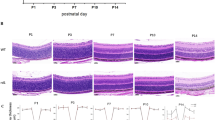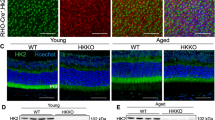Abstract
Here we describe two families with retinitis pigmentosa, a hereditary neurodegeneration of rod and cone photoreceptors in the retina. Affected family members were homozygous for loss-of-function mutations in IDH3B, encoding the β-subunit of NAD-specific isocitrate dehydrogenase (NAD-IDH, or IDH3), which is believed to catalyze the oxidation of isocitrate to α-ketoglutarate in the citric acid cycle. Cells from affected individuals had a substantial reduction of NAD-IDH activity, with about a 300-fold increase in the Km for NAD. NADP-specific isocitrate dehydrogenase (NADP-IDH, or IDH2), an enzyme that catalyzes the same reaction, was normal in affected individuals, and they had no health problems associated with the enzyme deficiency except for retinitis pigmentosa. These findings support the hypothesis that mitochondrial NADP-IDH, rather than NAD-IDH, serves as the main catalyst for this reaction in the citric acid cycle outside the retina, and that the retina has a particular requirement for NAD-IDH.
This is a preview of subscription content, access via your institution
Access options
Subscribe to this journal
Receive 12 print issues and online access
$209.00 per year
only $17.42 per issue
Buy this article
- Purchase on Springer Link
- Instant access to full article PDF
Prices may be subject to local taxes which are calculated during checkout





Similar content being viewed by others
References
Hartong, D.T., Berson, E.L. & Dryja, T.P. Retinitis pigmentosa. Lancet 368, 1795–1809 (2006).
Daiger, S.P. Identifying retinal disease genes: how far have we come, how far do we have to go? Novartis Found. Symp. 255, 17–27 (2004).
Losson, R. & Lacroute, F. Interference of nonsense mutations with eukaryotic messenger RNA stability. Proc. Natl. Acad. Sci. USA 76, 5134–5137 (1979).
Noensie, E.N. & Dietz, H.C. A strategy for disease gene identification through nonsense-mediated mRNA decay inhibition. Nat. Biotechnol. 19, 434–439 (2001).
Huusko, P. et al. Nonsense-mediated decay microarray analysis identifies mutations of EPHB2 in human prostate cancer. Nat. Genet. 36, 979–983 (2004).
Dybbs, M., Ngai, J. & Kaplan, J.M. Using microarrays to facilitate positional cloning: identification of tomosyn as an inhibitor of neurosecretion. PLoS Genet. 1, 6–16 (2005).
Meindl, A. et al. A gene (RPGR) with homology to the RCC1 guanine nucleotide exchange factor is mutated in X-linked retinitis pigmentosa (RP3). Nat. Genet. 13, 35–42 (1996).
Schwahn, U. et al. Positional cloning of the gene for X-linked retinitis pigmentosa 2. Nat. Genet. 19, 327–332 (1998).
Gu, J.J., Spychala, J. & Mitchell, B.S. Regulation of the human inosine monophosphate dehydrogenase type I gene. Utilization of alternative promoters. J. Biol. Chem. 272, 4458–4466 (1997).
Vithana, E.N. et al. A human homolog of yeast pre-mRNA splicing gene, PRP31, underlies autosomal dominant retinitis pigmentosa on chromosome 19q13.4 (RP11). Mol. Cell 8, 375–381 (2001).
McKie, A.B. et al. Mutations in the pre-mRNA splicing factor gene PRPC8 in autosomal dominant retinitis pigmentosa (RP13). Hum. Mol. Genet. 10, 1555–1562 (2001).
Chakarova, C.F. et al. Mutations in HPRP3, a third member of pre-mRNA splicing factor genes, implicated in autosomal dominant retinitis pigmentosa. Hum. Mol. Genet. 11, 87–92 (2002).
Kim, Y.O. et al. Assignment of mitochondrial NAD+-specific isocitrate dehydrogenase beta subunit gene (IDH3B) to human chromosome band 20p13 by in situ hybridization and radiation hybrid mapping. Cytogenet. Cell Genet. 86, 240–241 (1999).
Ramachandran, N. & Colman, R.F. Chemical characterization of distinct subunits of pig heart DPN-specific isocitrate dehydrogenase. J. Biol. Chem. 255, 8859–8864 (1980).
Dolphin, D., Poulson, R. & Avramovic, O. Pyridine Nucleotide Coenzymes Part B, Coenzymes and Cofactors 606 (Wiley-Interscience, New York, 1987).
Cohen, P.F. & Colman, R.F. Diphosphopyridine nucleotide dependent isocitrate dehydrogenase from pig heart. Characterization of the active substrate and modes of regulation. Biochemistry 11, 1501–1508 (1972).
Soundar, S., Park, J.H., Huh, T.L. & Colman, R.F. Evaluation by mutagenesis of the importance of 3 arginines in alpha, beta, and gamma subunits of human NAD-dependent isocitrate dehydrogenase. J. Biol. Chem. 278, 52146–52153 (2003).
Garrett, R.H. & Grisham, C.M. Biochemistry 618 (Brooks Cole, Belmont, California, USA, 2004).
Hoek, J.B. & Rydstrom, J. Physiological roles of nicotinamide nucleotide transhydrogenase. Biochem. J. 254, 1–10 (1988).
Moyle, J. & Mitchell, P. The proton-translocating nicotinamide-adenine dinucleotide (phosphate) transhydrogenase of rat liver mitochondria. Biochem. J. 132, 571–585 (1973).
Smith, C.M. & Plaut, G.W. Activities of NAD-specific and NADP-specific isocitrate dehydrogenases in rat-liver mitochondria. Studies with D-threo-alpha-methylisocitrate. Eur. J. Biochem. 97, 283–295 (1979).
Li, C. & Hung, W.W. Model-based analysis of oligonucleotide arrays: model validation, design issues and standard error application. Genome Biol. 2, RESEARCH0032 (2001).
Warburg, O. & Christian, W. Isolierung und Kristallisation des Gärungsferments Enolase. Biochem. Z. 310, 384–421 (1941).
Acknowledgements
This work was supported by the Foundation Fighting Blindness and the US National Institutes of Health (NIH-EY00169, NIH-EY08683, NIH-HL67774 and P30-EY014104). The microarray analyses were carried out at the Microarray Core Facility at Dana-Farber Cancer Institute.
Author information
Authors and Affiliations
Contributions
D.T.H., T.L.M. and T.P.D. designed and conducted the molecular genetic analyses. E.L.B. clinically evaluated, selected and recruited affected individuals and their family members and helped design the study. M.D. and R.F.C. designed and conducted the enzyme assays. All authors discussed and interpreted the results and wrote the manuscript.
Corresponding author
Ethics declarations
Competing interests
All authors declare that there is no conflict of interest. T.P.D. may appear to have a conflict of interest because he currently works for Novartis, a publicly traded pharmaceutical company. He is also still a faculty member at Harvard Medical School (part time). T.P.D. affirms that his position at Novartis does not entail any conflict of interest with the manuscript. His contributions to this study were mostly carried out before beginning his position at Novartis, and the entire body of research is unrelated to his employment at Novartis, was not sponsored by Novartis, and has no bearing on research or clinical programs at Novartis.
Supplementary information
Supplementary Text and Figures
Supplementary Tables 1–4, Supplementary Methods, Supplementary Note (PDF 105 kb)
Rights and permissions
About this article
Cite this article
Hartong, D., Dange, M., McGee, T. et al. Insights from retinitis pigmentosa into the roles of isocitrate dehydrogenases in the Krebs cycle. Nat Genet 40, 1230–1234 (2008). https://doi.org/10.1038/ng.223
Received:
Accepted:
Published:
Issue Date:
DOI: https://doi.org/10.1038/ng.223
This article is cited by
-
Photoreceptor metabolic reprogramming: current understanding and therapeutic implications
Communications Biology (2021)
-
Structure and allosteric regulation of human NAD-dependent isocitrate dehydrogenase
Cell Discovery (2020)
-
Hexokinase 2 is dispensable for photoreceptor development but is required for survival during aging and outer retinal stress
Cell Death & Disease (2020)
-
Loss of IDH2 Accelerates Age-related Hearing Loss in Male Mice
Scientific Reports (2018)
-
Reprogramming the metabolome rescues retinal degeneration
Cellular and Molecular Life Sciences (2018)



